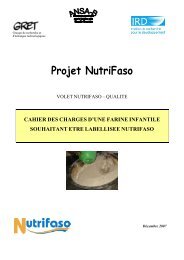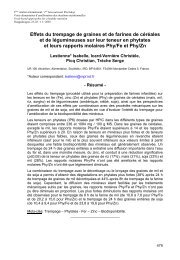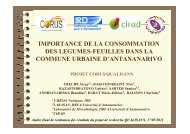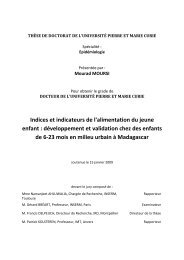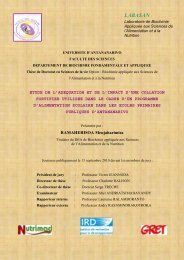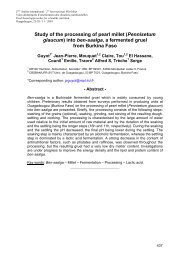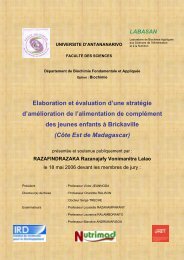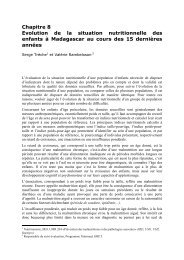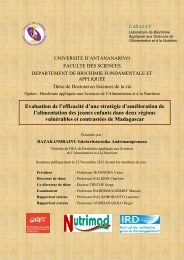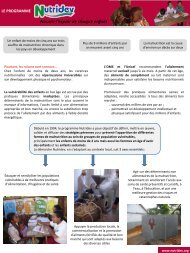THESE UNIQUE El Hassane Kéhien-Piho TOU - Nutridev
THESE UNIQUE El Hassane Kéhien-Piho TOU - Nutridev
THESE UNIQUE El Hassane Kéhien-Piho TOU - Nutridev
Create successful ePaper yourself
Turn your PDF publications into a flip-book with our unique Google optimized e-Paper software.
E.H. Tou et al. / International Journal of Food Microbiology 106 (2006) 52–60 59<br />
more easily available to LAB through reduction in size during<br />
grinding of the grains and also possibly by the autolysis of<br />
yeasts or other biological factors. The soaking step can thus be<br />
regarded as a fermentation process, which combines substrate<br />
diffusion out of the grains and metabolic activity of the<br />
microorganisms during which ethanol production relies mainly<br />
on the fermentation of glucose, fructose and maltose. Sucrose,<br />
which is the main disaccharide of the grains, was not detected<br />
as a substrate in the soaking water, probably due to endogenous<br />
invertase activity in the grain converting sucrose into glucose<br />
and fructose and/or a perfect coupling between the diffusion<br />
rate and consumption rate by microorganisms. This hypothesis<br />
is currently being further investigated.<br />
For the settling step, glucose and fructose appeared to be the<br />
main substrates for lactic acid fermentation. However, a closer<br />
examination of data brought to light an unbalanced situation,<br />
since the production of around 10 mmol/l of ethanol and 30<br />
mmol/l of lactic acid, i.e. a total of 40 mmol/l of fermentation<br />
end-products, cannot be explained by an initial concentration of<br />
8 and 3.6 mmol/l of glucose and fructose, respectively. From the<br />
total concentration of the end-products it can be inferred that 20<br />
mmol/l of ‘‘glucose equivalent’’ (considered as glucose and<br />
fructose) would have been necessary, taking as hypothesis that 2<br />
mol of fermentation end-product (i.e. ethanol or lactic acid) are<br />
formed per mole of substrate, and that fructose is used as<br />
substrate and not as an electron acceptor. Thus, such a balance<br />
highlights a deficit in substrate for fermentation and suggests the<br />
use of an additional carbon source, probably starch, which is<br />
widely available in the pearl millet grain. This hypothesis is<br />
consistent with the presence during the settling step of<br />
amylolytic lactic acid bacteria, and suggests an active role<br />
during fermentation. This is also consistent with other reports on<br />
their presence at similar ratios in other traditional fermented<br />
cereal pastes and dough (Diaz-Ruiz et al., 2003; Johansson et al.,<br />
1995; Sanni et al., 2002) and with the ability of their a-amylase<br />
to hydrolyse native starch (Rodriguez-Sanoja et al., 2000).<br />
5. Conclusion<br />
This study of the processing of pearl millet into ben-saalga<br />
allowed a detailed flow diagram to be established and<br />
fermentation steps to be characterized, providing a rational<br />
basis for further investigations to ensure reproducible conditions<br />
for the production of constant food quality. However, if<br />
some information has been obtained on changes in nutritional<br />
characteristics during processing, a more detailed study is<br />
required to improve not only production conditions but also<br />
gruel nutritional characteristics. Particular attention will have to<br />
be paid to identifying methods to improve the energy and<br />
nutrient density of traditional gruels.<br />
Acknowledgements<br />
This work was performed in the framework of the project<br />
Cerefer (www.mpl.ird.fr/cerefer/) funded by the European<br />
Commission, Contract No. ICA4-CT-2002-10047.<br />
References<br />
Blandino, A., Al-Aseeri, M.E., Pandiella, S.S., Cantero, D., Webb, C., 2003.<br />
Cereal-based fermented foods and beverages. Food Research International<br />
36, 527–543.<br />
Bookwalter, G.N., Peplinski, A.J., Pfeifer, V.F., 1968. Using a Bostwick<br />
consistometer to measure consistencies of processed corn meals and their<br />
CSM blends. Cereal Science Today 13 (11), 407–410.<br />
Calderon, M., Loiseau, G., Guyot, J.P., 2001. Nutritional requirements and<br />
simplified cultivation medium to study growth and energetics of a<br />
sourdough lactic acid bacterium Lactobacillus fermentum Ogi E1 during<br />
heterolactic fermentation of starch. Journal of Applied Microbiology 90,<br />
508–516.<br />
Cerefer, 2003. European Commission, Annual Report of the European INCO-<br />
DEV Project (5th FP), Contract No.ICA4-CT2002-100471: ?Meeting<br />
consumer requirements for cereal based fermented foodstuffs with<br />
improved nutritional and sanitary quality and shelf-life in AfricaX, Oct.<br />
2002–2003. Report available at: http://www.mpl.ird.fr/cerefer/.<br />
Dewey, K.G., Brown, K.H., 2003. Update on technical issues concerning<br />
complementary feeding of young children in developing countries and<br />
implications for intervention programs. Food and Nutrition Bulletin 24,<br />
5–28.<br />
Diaz-Ruiz, G., Guyot, J.P., Ruiz-Teran, F., Morlon-Guyot, J., Wacher, C., 2003.<br />
Microbial and physiological characterization of weak amylolytic but fast<br />
growing lactic acid bacteria: a functional role in supporting microbial<br />
diversity in pozol, a Mexican maize sourdough. Applied and Environmental<br />
Microbiology 69, 4367–4374.<br />
Hounhouigan, D.J., Jansen, J.M.M., Nout, M.J.R., Nago, C.M., Rombouts,<br />
F.M., 1991. Production and quality of maize-based fermented dough in<br />
Benin urban area. Proceedings of regional workshop on traditional African<br />
foods. Quality Nutrition, 9 – 18 (25–29 Oct.)<br />
Hounhouigan, D.J., Nout, M.J.R., Nago, C.M., Houben, J.H., Rombouts, F.M.,<br />
1993. Changes in the physico-chemical properties of maize during natural<br />
fermentation of Mawè. Journal of Cereal Science 17, 291–300.<br />
Johansson, M.L., Sanni, A., Lonner, C., Molin, G., 1995. Phenotypically-based<br />
taxonomy using API 50 CH of lactobacilli from Nigerian Ogi, and the<br />
occurrence of starch fermenting strains. International Journal of Food<br />
Microbiology 25, 159–168.<br />
Kingamkono, R., Sjögren, E., Svanberg, U., Kaijser, B., 1994. pH and acidity<br />
in lactic-fermenting cereal gruels: effects on viability of enteropathogenic<br />
microorganisms. World Journal of Microbiology and Biotechnology 10,<br />
664–669.<br />
Kitabatake, N., Gimbi, D.M., Oi, Y., 2003. Traditional non-alcoholic<br />
beverage, togwa, in East Africa, produced from maize flour and<br />
germinated finger millet. International Journal of Food Sciences and<br />
Nutrition 54, 447–455.<br />
Lei, V., Jakobsen, M., 2004. Microbiological characterization and probiotic<br />
potential of koko and koko sour water, African spontaneously<br />
fermented millet porridge and drink. Journal of Applied Microbiology<br />
96 (2), 384–397.<br />
Lorri, W., Svanberg, U., 1993. Lactic acid-fermented cereal gruels: viscosity<br />
and flour concentration. International Journal of Food Sciences and<br />
Nutrition 44, 207–213.<br />
Lorri, W., Svanberg, U., 1994. An overview of the use of fermented<br />
foods for child feeding in Tanzania. Ecology of Food and Nutrition 34,<br />
65–81.<br />
Lutter, C.K., Dewey, K.G., 2003. Nutrient composition for fortified complementary<br />
foods: proposed nutrient composition for fortified complementary<br />
foods. Journal of Nutrition 133, 3011S–3020S.<br />
Mensah, P., Tomkins, A.M., Draser, B.S., Harrison, T.J., 1991. Antimicrobial<br />
effect of fermented Ghanaian maize dough. Journal of Applied Bacteriology<br />
7, 203–210.<br />
Nout, M.J.R., Motarjemi, Y., 1997. Assessment of fermentation as a household<br />
technology for improving food safety: a joint FAO/WHO workshop. Food<br />
Control 8, 221–226.<br />
Nout, M.J.R., Rombouts, F.M., Havelaar, A., 1989. Effect of accelerated natural<br />
lactic fermentation of infant food ingredients on some pathogenic<br />
microorganisms. International Journal of Food Microbiology 8, 351–361.



